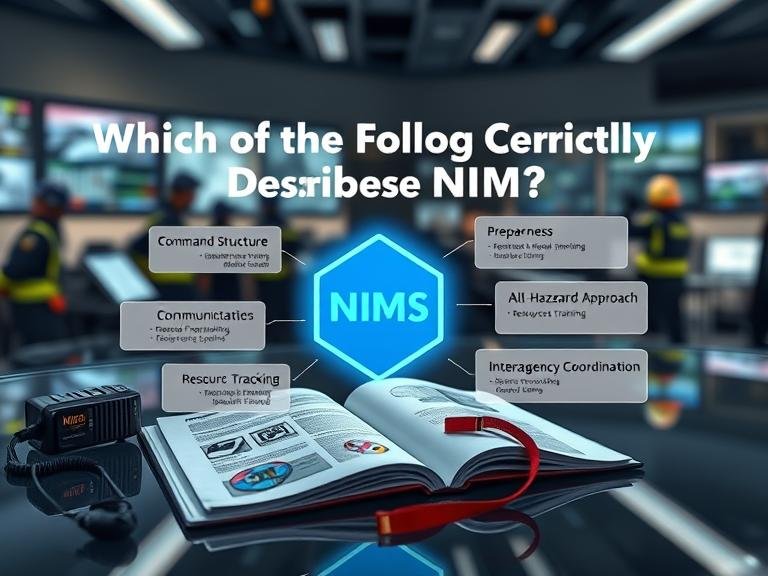Which of the Following Correctly Describes NIMS? The National Incident Management System (NIMS) is the United States’ standardized framework for responding to emergencies, from natural disasters to terrorist attacks. Established by the Department of Homeland Security (DHS) in 2004, NIMS ensures coordination among federal, state, local, tribal, and private-sector organizations during crises.
This article clarifies:
✔ What NIMS is (and what it is not)
✔ Core components of the NIMS framework
✔ How NIMS differs from other emergency systems
✔ FAQs on NIMS implementation and compliance
Table of Contents
What Is NIMS?
NIMS is a comprehensive, nationwide approach to incident management designed to:
- Improve interoperability between agencies
- Standardize command structures
- Enhance resource coordination
- Support scalable responses (small incidents to catastrophic events)
NIMS Is NOT:
❌ A response plan (it’s a framework for creating plans)
❌ Exclusive to government agencies (private sector can adopt it)
❌ The same as ICS (Incident Command System)—ICS is part of NIMS
Core Components of NIMS
NIMS operates through six key pillars:
1. Command and Management
- Incident Command System (ICS): Hierarchical structure for on-scene management.
- Multiagency Coordination: Ensures agencies work together (e.g., FEMA and local fire departments).
- Public Information Systems: Coordinates crisis messaging.
2. Preparedness
- Training (e.g., NIMS courses via FEMA’s Emergency Management Institute).
- Equipment and resource certification.
- Drills and exercises.
3. Resource Management
Standardizes how resources (personnel, equipment, supplies) are:
- Identified
- Requested
- Deployed
4. Communications and Information Management
- Requires interoperable communication systems.
- Establishes protocols for data sharing.
5. Ongoing Management and Maintenance
- Regular updates to NIMS guidelines.
- Compliance monitoring.
6. Intelligence/Investigations (Added in 2017)
Integrates law enforcement and cybersecurity into incident response.
How NIMS Differs from Other Systems
| System | Purpose | Relation to NIMS |
|---|---|---|
| ICS | On-scene incident management | Subset of NIMS |
| NRF (National Response Framework) | Guides how to respond | Uses NIMS for operational structure |
| HSEEP (Homeland Security Exercise and Evaluation Program) | Training | Aligns with NIMS preparedness |
FAQs About NIMS
1. Who must comply with NIMS?
All federal agencies; state/local/tribal governments receiving federal grants; and recommended for private-sector partners.
2. Is NIMS only for natural disasters?
No—it applies to all hazards (terrorism, pandemics, cyberattacks, etc.).
3. What’s the difference between NIMS and ICS?
- ICS = Tactical field operations.
- NIMS = Broader framework including ICS, plus policy, training, and resource protocols.
4. How do organizations implement NIMS?
- Complete FEMA’s NIMS training courses (e.g., IS-700.b).
- Adopt ICS in operations.
- Align resource-management practices with NIMS standards.
5. Can NIMS be used internationally?
While designed for the U.S., its principles are adapted globally (e.g., Canada’s ICS).
6. Has NIMS been used in real incidents?
Yes—Hurricane Katrina (2005), COVID-19 pandemic, and wildfire responses.
Why NIMS Matters
NIMS prevents chaos during emergencies by:
✔ Eliminating conflicting procedures across agencies.
✔ Accelerating resource deployment through standardized requests.
✔ Improving public communication with unified messaging.
Example: During a hurricane, NIMS ensures fire departments, hospitals, and FEMA share terminology, avoid duplication, and prioritize lifesaving actions.
Conclusion: Identifying Correct NIMS Descriptions
When asked “Which of the following correctly describes NIMS?”, look for these key points:
✅ A standardized framework for incident management.
✅ Includes ICS, multiagency coordination, and resource protocols.
✅ Mandatory for federal grantees, voluntary for others.
✅ Focused on all-hazards preparedness.
Misconceptions to Avoid:
- NIMS is not a standalone response plan.
- It does not replace local emergency operations plans.
For training, visit FEMA’s NIMS Training Program (link).

